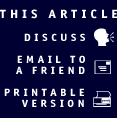 |
|
|
 Any Path Will Do Any Path Will DoBy Robert C. Heterick heterick@vt.edu Originally published in The Learning MarketSpace, December 1, 2000. http://www.center.rpi.edu/LForum/LdfLM.html As traditional colleges and universities feint, dodge, weave, stumble and sometimes fumble in their move toward the incorporation of technology- based learning strategies, a sort of Alice in Wonderland aura permeates the educational landscape--if you don't know where you are going, any path will do. We sometimes wonder if our traditional institutions of higher learning have seriously stopped to consider the likely outcomes of the increasingly significant infusion of computer and communications technology into the teaching/learning process. If they had, it would be difficult to explain some of the choices being made. There is an element of wisdom in the old technology maxim, "It only took God six days to make the heavens and the earth because he didn't have an installed base to worry about." New, commercial entrants in the higher education market currently have the edge precisely because they don't have an installed base to worry about. Our long-established institutions, while not necessarily moribund, suffer from the inertia of several hundred years of tradition that make change on any significant scale exceedingly difficult. As the focus shifts from teaching to learning, a number of changes will become increasingly obvious. Just as the student will become more responsible for his or her learning outcomes, we can expect the student to become responsible for setting his or her educational agenda. There are certainly historical antecedents for this. It was well into the 19th century before an established curriculum, leading to a four year under- graduate degree, became the norm. Prior to that time, and even into the 20th century, it was not uncommon for students to pick and choose courses at the university and, when they felt themselves ready, to leave with letters of recommendation from various faculty that they felt would open the necessary doors to a long and rewarding career. In today's world, the number of university drop-outs who have created the engine that fuels our booming economy is legend. It hasn't escaped observation that Microsoft has created many more millionaires from its staff roster than has the National Football League from its. All this may signal the resurgence of the professorate. Educational institutions have long struggled with the limited allegiance of their faculty who, especially in the case of research institutions, have been focused more on their professional discipline rather than their employer of record. New organizational structures to deliver learning opportunities with technology seem likely to further exacerbate this long standing concern. Just as the marginal farmer, who could provide subsistence for his family and a few others, has shrunk to near invisibility, so too will the lecturer who can provide a learning opportunity for only 50 or 100 students at a time. Those faculty (more likely teams of faculty) who can provide compelling learning experiences for literally thousands of students may become like successful researchers and football coaches and their staffs--greatly in demand and following the money. As the student takes increasing responsibility for his or her education, it seems likely that the funding which has been directed to the institution will begin to shift to the student. We have a little taste of this with the beginning of state scholarship funds directed to the student and with the rise of state support for secondary students in charter and private schools. We hear rumblings in the legislatures of several states about funding the consumer rather than the provider and there is clear evidence that significant amounts of federal educational support are beginning to follow this model. Directing support to students rather than institutions will increase the aggressiveness of potential commercial competitors. Unencumbered with the inertia confronting our traditional institutions, they will be formidable competitors. Unlinking financial support from a formal degree would further pressure educational institutions who eschew learning opportunities outside their degree curricula. Enrollment competition--which has generally been an issue only for second tier, high cost, private institutions and institutions in states with declining or only marginally growing populations--will become a major issue for all but a few high prestige institutions. Many traditional institutions will find themselves "over built" in terms of bricks and mortar. Maintenance of an under-utilized physical plant could become a significant competitive deterrent for some. The more significant issue may be the potentially precipitous decline in the number of students actually seeking the four-year undergraduate degree. Life-long learning and job re-skilling are likely to be the goals of the vast majority of people pursuing post-secondary learning experiences. It seems likely that three-quarters of the enrollment in post-secondary learning will not have degree expectations or intentions. Fewer than one-fourth of all current students are seeking the "undergraduate experience" as a full-time, residential student. That percentage can be expected to continue to diminish. For the majority student, credit-for-contact is of little import but certification of learning is critical. To accommodate this majority, we can expect to see an increased emphasis on outcomes assessment and a decreased focus on seat time. As more and more regional and statewide asynchronous learning institutions such as the Western Governorsí and Kentucky Virtual universities come into existence, the rise of credit banks and transfer-of- credit agreements should be expected. While conferring a degree on a student who has never set foot on the campus, or possibly never completed a course taught by the institution, is a specter that haunts most traditional institutions, new providers can be expected to emerge to meet student demand for certification. The comfortable rhythm of the 15-week semester will be shattered. Students will begin the study of a "course" at anytime and will finish at anytime. Traditional institutions of higher learning will be confronted with scheduling issues that boggle the mind. Student progress and "eligibility" will require new definitions. These are not new problems to the dot.com world, but our traditional institutions of higher learning are not necessarily adept at operating in Internet time. If you think you know where you are going, the path really does make a difference. |

